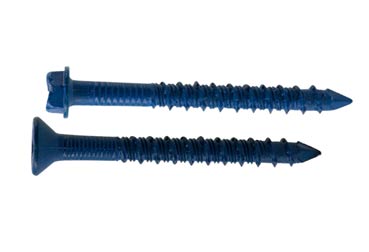Factors to Consider Before Installing Cement Screws
It is always necessary to use the accurate fastener in certain cases, so as to ensure that the installation is carried out correctly. The cement or concrete screw is a special kind of fastener, specifically manufactured to tap its own threads into a pre-drilled hole in various types of base materials including brick, concrete, brick and block.
The leading manufacturing brand, Tapcon® was the first to introduce such kind of rivet in the market. This screw was patented in 1976 by ITW Buildex. These screws are mostly popular for their easy installation feature and superior pull-out resistance and high holding qualities.

Cement Screw Threads
In the binding material anchoring industry, the threads of such types of fasteners are referred as “High-Low”. These types of threads enable quick and complete dust removal during the installation procedure. Their “High-Low” characteristics further enable the fastener to tap its threads steadily, thereby delivering high-standard performance.
While installing always remember that removal of dust is necessary, as the dust present inside the pre-drilled hole may affect the installation process. Dust is usually created in the hole when the threads cut into the surface, so always clean up the hole as soon as it is created. This will ensure you smooth and proper installation, with less amount of torque required to penetrate the screw into the hard surface.
And if you delay the cleaning up of dust process then numerous problems may arise. The screw can get stuck in the hole, thereby preventing further insertion and you would face much difficulty to remove the screw. Also, if the screw gets stuck in the hole and in order to move it if we apply too much of torque then the head of the fastener can be snipped off. As the lead thread cuts off of the base material, so it’s highly important to maintain the quality of the steel as well as the thread.
Diameter of Hole of Concrete Screws
As with all cement anchors, the hole tolerance is quite critical. Let’s say for a 3/16″ diameter screw, the hole diameter should be of 5/32″. And if you are using a screw with a 1/4″ diameter then the required hole diameter should be 3/16″. You should always use a hammer drill and compare the tolerance carbide-tipped masonry bits when installing cement screws.
Proper Fastening
Concrete screws require a minimum plunge of 1″ and maximum should be around 1-3/4″ into the base material. An implantation of less than 1″ should not be done, as it reduces the holding values of the screw.
With a proper knowledge, we can always make correct use of the cement screws in the construction project.
Leave a Reply